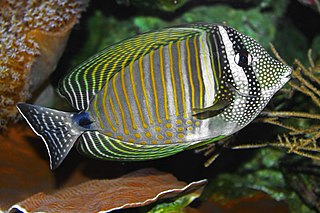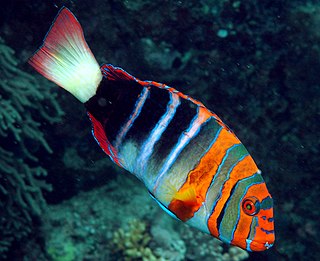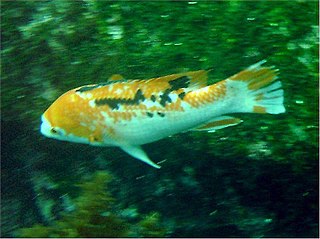
Zebrasoma desjardinii, the Red Sea sailfin tang, Desjardin's sailfin tang, Indian sailfin tang or Indian sailfin surgeonfish, is a species of marine ray-finned fish belonging to the family Acanthuridae, the surgeonfishes, unicornfishes and tangs. This fish is found in the Indian Ocean.

Johann Lukas Schönlein was a German naturalist, and professor of medicine, born in Bamberg. He studied medicine at Landshut, Jena, Göttingen, and Würzburg. After teaching at Würzburg and Zurich, he was called to Berlin in 1839, where he taught therapeutics and pathology. He served as physician to Frederick William IV.

Choerodon is a genus of wrasses native to the Indian Ocean and the western Pacific Ocean. They are commonly referred to as tuskfish, because most species have sharp tusk-like teeth.

Reganochromis calliurus is a species of cichlid endemic to Lake Tanganyika in East Africa. It lives over a sandy substrate in deeper coastal waters, to depths of at least 60 m (200 ft). Its preferred diet consists mostly of shrimp. It can reach a total length of 15 cm (5.9 in). This fish can also be found in the aquarium trade. It is currently the only known member of its genus.

The giant cichlid, also known as the emperor cichlid, is a species of fish in the family Cichlidae, endemic to Lake Tanganyika in Africa. It is the only member of its genus Boulengerochromis and tribe Boulengerochromini.
Baileychromis centropomoides is a species of cichlid endemic to Lake Tanganyika in east Africa. This fish grows to a length of 16.8 centimetres (6.6 in) TL. It is currently the only known member of its genus. The generic name is a compound noun, made up of the surname Bailey, in honour of the American ichthyologist Reeve Maclaren Bailey (1911-2011) of the University of Michigan, and the Greek word chromis which was used by Aristotle for a type of fish. This was probably the drum Sciaenidae and may be derived from the word chroemo which means "to neigh" in reference to the noise made by drums. This word was applied to a number of percomorph fishes, such as damselfish, cardinalfish, dottybacks, wrasses and cichilds, by ichthyologists as these were thought to be closely related.

The Azurio tuskfish, also known as the scarbreast tuskfin, is a species of wrasse native to the western Pacific, where it occurs off the coasts of eastern Asia. It can be found in areas with rocky substrates at depths from 8 to 50 m. This species can reach a length of 40 cm (16 in). It can be found in the aquarium trade. It is threatened by overfishing and habitat loss; it is a popular target for spearfishers and is considered an excellent food fish.

The bluespotted tuskfish is a species of wrasse native to the coastal waters of northwestern Australia. They occur in reef environments, preferring areas with sandy substrates or weedy growth. This species can reach a length of 36 cm (14 in).

Koumansetta rainfordi, the old glory or Court Jester goby, is a species of goby native to tropical reefs of the western Pacific Ocean where it occurs at depths of from 2 to 30 metres. This species can reach a length of 8.5 centimetres (3.3 in) SL. It can also be found in the aquarium trade. The specific name honours the viticulturalist E. H. Rainford, of the Queensland Agricultural Department, who also collected specimens for the Australian Museum, and in 1924 he collected specimens of this species.

Hector's goby is a species of goby native to the Indian Ocean to the islands of Micronesia in the western Pacific Ocean. It can be found on sheltered coral reefs at depths of from 3 to 30 metres. This species reaches a length of 8.5 centimetres (3.3 in) SL. It can also be found in the aquarium trade. The specific name honours Gordon Hector who was Chief Secretary to the Government of the Seychelles, in gratitude for his help to Smith's work in the Seychelles.

Amblyeleotris wheeleri, the Gorgeous prawn-goby, is a species of goby native to tropical reefs of the Indian Ocean to the western Pacific Ocean. It can be found at depths of from 5 to 40 metres though is usually does not occur deeper than 15 metres (49 ft). It is a commensal with alpheid shrimps, most often being found in association with Alpheus ochrostriatus. This species can reach a length of 10 centimetres (3.9 in) SL. It can also be found in the aquarium trade.

Jansen's wrasse is a species of ray-finned fish, a wrasse from the family Labridae which is native to the Indian Ocean and Pacific Ocean. In the south-western Pacific Ocean it is replaced by sibling species black-barred wrasse. It can be found in the aquarium trade.

The harlequin tuskfish, Choerodon fasciatus, is a species of wrasse native to the western Pacific Ocean. It occasionally makes its way into the aquarium trade.

The yellowface pikeblenny is a species of chaenopsid blenny found in coral reefs in the western central Atlantic, including the Bahamas and Caribbean. It can reach a maximum length of 8.5 centimetres (3.3 in) TL. This species feeds primarily on crustaceans, finfish, and worms and can be found in the commercial aquarium trade. The specific name honours the zoologist, diver and underwater photographer Conrad Limbaugh (1925-1960).

Centropyge fisheri, the orange angelfish, whitetail angelfish, damsel angelfish, yellowtail angelfish, Hawaiian flame angelfish, Fisher’s angelfish, Fisher’s dwarf angelfish or Fisher’s pygmy angelfish, is a species of marine ray-finned fish, a marine angelfish belonging to the family Pomacanthidae. It is found in the Indo-Pacific region.
Gerald Robert "Gerry" Allen is an American-born Australian ichthyologist. His career began in 1963, when he spent a semester at the University of Hawaii, where he also received a PhD in marine zoology in 1971. In 1972, Allen wrote his doctoral thesis on the systematics and biology of the anemone fish.

The orange-dotted tuskfish is a species of wrasse native to the Indian Ocean from Sri Lanka eastward to French Polynesia in the western Pacific. Its range extends north to the Ryukyus and south to New Caledonia. It inhabits reefs at depths from 1 to 25 m (3.3–82.0 ft). This species can reach a length of 50 cm (20 in). It is commercially important, and can be found in the aquarium trade.

The blackear wrasse is a species of wrasse, a type of fish in the family Labridae, from the warmer waters of the western Atlantic Ocean.

Halichoeres hartzfeldii, also known as Hartzfeld's wrasse, is a species of salt water wrasse found in the western Pacific Ocean.

Bodianus eclancheri, commonly known as the harlequin wrasse, is a species of wrasse. It is found in the south-eastern Pacific Ocean.



















